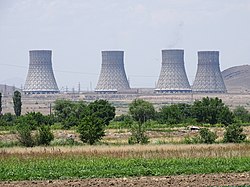
Energy in Armenia is mostly from natural gas. [1] Armenia has no proven reserves of oil or natural gas and currently imports most of its gas from Russia. The Iran-Armenia Natural Gas Pipeline has the capacity to equal imports from Russia. [2]
Contents
- History and geopolitics
- Rankings
- Primary energy supply
- Natural reserves
- Oil
- Proposed Iranian pipeline
- Natural gas
- Russian-Georgian pipeline
- Iranian pipeline
- Pricing
- Electricity
- Nuclear power
- Fossil gas power
- Hydro
- Solar
- Renewable energy
- See also
- Notes
- External links
Despite a lack of fossil fuel, there are significant domestic resources to generate electricity in Armenia. The Armenian electrical energy sector has had a surplus capacity ever since emerging from a severe post-Soviet crisis in the mid-1990s, thanks to the reopening of the Metsamor Nuclear Power Plant, which was built in 1979 and supplies over 40% of the country's electricity. [3] Armenia has plans to build a new nuclear power plant in order to replace the aging and dangerous [4] Metsamor, possibly a small modular reactor. [5] The country also has eleven hydroelectric power plants and has plans to build a geothermal power plant in Syunik. Most of the rest of Armenia's electricity is generated by the natural gas-fired thermal power plants in Yerevan (completed in 2010) and Hrazdan.
Upon gaining independence, Armenia signed the European Energy Charter in December 1991, the charter is now known as the Energy Charter Treaty which promotes integration of global energy markets. [6] Armenia is also a partner country of the EU INOGATE energy programme, which has four key topics: enhancing energy security, convergence of member state energy markets on the basis of EU internal energy market principles, supporting sustainable energy development, and attracting investment for energy projects of common and regional interest. [7] Since 2011, Armenia holds observer member status in the EU's Energy Community.









